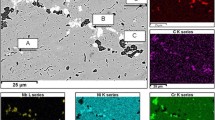Abstract
Acoustic emission (AE) was used to monitor the scale cracking and spalling of Ni-30Cr alloy samples that had been oxidized at 1000°C for 2 hours or 20 hours then cooled slowly to room temperature in two different ways: natural furnace cooling or constant-rate cooling at a rate of about 19°C/ hour. The morphology of the remaining scale and spalled areas was observed by scanning electron microscope (SEM). The AE results show that the scale started to crack and spall continuously during cooling when a certain temperature was reached. The cracking and spalling continued over a temperature range, indicating that there is distribution of the critical-fracture stresses. The SEM analysis shows that the interface between the Cr2O3 scale and the Ni-30Cr alloy substrate is relatively weak. Under this condition, a mathematical model proposed by A. G. Evans can be used to estimate the size of the spalled areas and the critical size of the interfacial flaws required to produce buckling. Measurements of the diameter of spalled areas from SEM images yielded a range of values that were well described by a normal distribution. By applying the Evans model to the AE data, normal distributions of the diameter of spalled areas were estimated, which were 2–3 times larger than the measured sizes. This lack of agreement may be because the model did not take into account stress-concentration effects of other defects, such as oxide grain boundaries, small porosity in the scale, or small V-notches between individual oxide crystals at the scale surface. It is suggested that the distribution of the interfacial-flaw sizes causes the distribution of the critical-fracture stresses that are inferred from the AE experiments.
Similar content being viewed by others
References
J. Stringer,Corros. Sci. 10, 513–543 (1970).
D. J. Baxter and K. Natesan,Rev. High Temp. Mater. 5, 149–250 (1983).
P. Hancock and R. C. Hurst, inAdvances in Corrosion Science and Technology, M. G. Fontana and R. W. Staehle, eds. (Plenum Press, New York, 1974), pp. 1–84.
J. K. Tien and J. M. Davidson, inStress Effect and the Oxidation of Metals, J. V. Cathcart, ed. (The Metallurgical Society of AIME, 1974), pp. 201–219.
H. E. Evans and R. C. Lobb,Corros. Sci. 24, 209–222 (1989).
H. E. Evans,Mater. Sci. Eng. A120, 139–146 (1989).
A. G. Evans and R. M. Cannon,Mater. Sci. Forum 43, 243–268 (1989).
A. G. Evans and J. W. Hutchinson,Int. J. Solids Struct. 20(5), 455–466 (1984).
A. G. Evans, G. B. Crumley, and R. E. Demaray,Oxid. Met. 20(5/6), 193–216 (1983).
J. J. Barnes, J. G. Goedjen, and D. A. Shores,Oxid. Met. 32(5/6), 449–469 (1989).
D. Zhu and D. A. Shores,Unpublished work.
J. H. Stout, J. G. Goedjen, Q. Guo, and D. A. Shores, inProceedings of the Symposium on X-Ray Methods in Corrosion and Interfacial Electrochemistry, A. Davenport and J. G. Gordon II, eds. (The Electrochemical Society, 1992), pp. 101–114.
B. B. Jha, B. Raj, and A. S. Khanna,Oxid. Met. 26, 263–273 (1986).
W. Christl, A. Rahmel, and M. Schutze,Mater. Sci. Eng. 87, 289–293 (1987).
H. E. Evans and R. C. Lobb, “Eurocorr 87” (Dechema, Frankfurt, 1987).
H. E. Evans,Mater. Sci. Technol. 4, 415–420 (1988).
Y. Zhang and D. A. Shores, inProceedings of the Symposium on Oxide Films on Metals and Alloys. B. R. MacDougall, R. S. Alwitt, and T. A. Ramanarayanan, eds. (The Electrochemical Society, Toronto, Canada, 1992), pp. 250–264.
F. H. Stott,Mater. Sci. Technol. 4, 431–438 (1988).
S. Timoshenko and J. M. Gere,Theory of Elastic Stability, 2nd Ed (McGraw Hill, New York, 1961).
Author information
Authors and Affiliations
Rights and permissions
About this article
Cite this article
Zhang, Y., Shores, D.A. Study of cracking and spalling of Cr2O3 scale formed on Ni-30Cr alloy. Oxid Met 40, 529–553 (1993). https://doi.org/10.1007/BF00666390
Received:
Issue Date:
DOI: https://doi.org/10.1007/BF00666390




